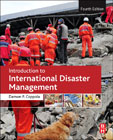
Introduction to International Disaster Management, Fourth Edition, was the first text of its kind and continues to serve as the leading, comprehensive overview of global emergency management. Offering an unbiased, global perspective, this valuable resource provides students and practitioners alike with a comprehensive understanding of the disaster management profession, covering the varied sources of risk and vulnerability; the systems that exist to manage hazard risk; and the many different stakeholders involved, from individuals to global organizations. This text also serves as a reference on scores of disaster management topics, including the various natural, technological, and intentional hazards, on international disaster management structures and systems, on global humanitarian spending and support, and many others. Taking a real world approach with considerable illustration through case studies, recent, and historical disaster events, it prepares students interested in joining the disaster management community to understand the work they will be doing, and assists those who already work with the disaster management community in any manner to better navigate this complex environment. Keeping pace with the continuous and rapid changes and advances in the field, Introduction to International Disaster Management, Fourth Edition, covers the many events and developments that have occurred since the prior edition, and provides instructor and student support to advance Emergency Management profession and practice. Thorough updates cover major disaster events that have occurred since late 2014, including: the Ebola epidemic, the Nepal Earthquake, the 2015/2016 Western U.S. Wildfires, the Indonesia Palm Oil Fires, Hurricanes Harvey, Irma, and Maria, the Mexico City Earthquake, emerging hazards like trash avalanches, and moreValuable introduction of the ground-breaking Sendai Framework for Disaster Risk Reduction (2015-2030) which was signed in March of 2015, and explanation of the relationship of this effort to the Sustainable Development Goals and the Paris AgreementNew section exploring the importance of global disaster risk reduction capacity building efforts Expanded information on the role of national militaries in humanitarian assistance and expected shifts in hazard risk on account of the changing climatePedagogical features, including Key Terms and Chapter Summaries, as well as Instructor Resources, support learning and instructionUseful disaster case studies that offer insightful perspectives on the events that have shaped the direction emergency management is taking todayUpdated statistics on disaster frequency and impact, to support a better understanding about how risk and vulnerability are changing, and whyInformation on multilateral emergency management agreements and the different mechanisms by which countries are agreeing to help each other before and after disasters occur, and the legal frameworks that support these agreementsProfiles of important NGOs and International Organizations, and their increasing prominence in international disaster management INDICE: 1. The Management of Disasters2. Hazards3. Risk and Vulnerability4. Mitigation5. Preparedness6. Response7. Recovery8. Participants: Governmental Disaster Management Agencies9. Participants: Nongovernmental Organizations, Academia, and the Private Sector10. Participants: Multilateral Organizations and International Financial Institutions11. Special Considerations
- ISBN: 9780128173688
- Editorial: Butterworth-Heinemann
- Encuadernacion: Rústica
- Páginas: 780
- Fecha Publicación: 01/01/2021
- Nº Volúmenes: 1
- Idioma: Inglés
